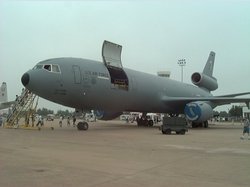Aircraft Perform Both Refueling And Airlift Missions
Jan. 17th was a special day for the KC-10 Extender community. It
marked the day KC-10s, aircrews and maintainers have been on
continuous deployment for 20 years -- 24 hours a day, seven days a
week, 365 days a year -- to Southwest Asia in support of combat
operations.

Photo Courtesy USAF
Facts show the KC-10 will pass a second milestone in March: 30
years of operational service. The KC-10 first entered the Air Force
inventory in 1981 and was assigned to Strategic Air Command, or
SAC. It remained a SAC asset until 1992 when it was reassigned to
the then newly created Air Mobility Command. Today, KC-10s are
based solely at Travis AFB and Joint Base McGuire-Dix-Lakehurst,
N.J.
Despite its small numbers -- there are only 59 in the inventory
-- and now lengthy time in service, Air Force warfighters routinely
rely on this tanker for both air refueling and airlift, operating
them at a steady pace all around the world supporting U.S.
operations. One such location is with the 380th Air Expeditionary
Wing's 908th Expeditionary Air Refueling Squadron at an air base in
Southwest Asia. KC-10s have been deployed to this specific location
for nearly all of the 20 years of continuous deployment.
"We've multiplied our KC-10 presence there several-fold since
the time I first deployed in 1996 and we're now staying three times
as long," said Lt. Col. Johnny Barnes, 9th Air Refueling Squadron
commander at Travis AFB. "We have numerous crewmembers with more
than 10 deployments under their belts and more than 300 combat
sorties."
Following the invasion of Kuwait by Iraqi forces in August 1990,
U.S. military forces and their allies initiated Operation Desert
Shield, history shows. This marked the beginning of the KC-10's
unbroken deployment string. SAC planners deployed seven KC-10s to
assist in the massive buildup of U.S. troops and equipment in the
Persian Gulf region and the air refueler has been there ever
since.

Photo Courtesy USAF
SAC officials later increased the number of tankers along the
route that included New England, the Azores, Egypt and Guam. And
although the KC-10 was constantly hauling cargo and troops,
statistics also show it consistently achieved the highest
mission-capable rates -- above 95 percent -- of any coalition
aircraft.
"Without the phenomenal tanker support we had for the war, we
could not have accomplished what we did," said retired Lt. Gen. Pat
Caruana during an August 2009 Tanker Living Legends Speaker Series
at Scott AFB, Ill. The general served as a U.S. Central Air Forces'
air campaign planner and commander directing strategic forces in
Saudi Arabia for both Desert Shield and Desert Storm.
The aircraft did more than provide just air refueling, General
Caruana said.
"The KC-10s were providing a majority of the airlift, especially
early on," he said.

Photo Courtesy USAF
Operations Desert Shield and Desert Storm resulted in the
largest air refueling operation ever conducted. The KC-10s and
KC-135 Stratotankers were credited with a total of 51,700 refueling
operations, delivering more than 125 million gallons of fuel. When
the actual fighting began Jan. 17, 1991, tankers were flying
missions not previously seen. "I can remember we had tankers
refueling F-15 (Eagles) at 3,000 feet right before the operation
began," General Caruana said. "They were flying low to avoid
radar.
When Operation Southern Watch was launched in 1991 to enforce
the Iraqi no-fly zone, KC-10s also were flying combat support
sorties. Since then, they have participated in operations Restore
Hope (Somalia), Deny Flight (Bosnia), Desert Fox (Iraq), Allied
Force (Kosovo), and tens of thousands of individual airlift and air
refueling missions.
When terrorists attacked the United States on its own soil on
Sept. 11, 2001, almost immediately KC-10s from JB McGuire were
airborne supporting the combat air patrols protecting U.S. skies as
part of Operation Noble Eagle. Tankers flew more than 350 sorties
in that operation with nearly one-third of those flights occurring
within the first three months after the attacks.
Now, nearly 10 years after the first of the Twin Towers fell in
New York City, KC-10s continue to play a vital role in protecting
the United States against attack. KC-10s have logged more than
106,000 flying hours. In 2009 alone, the tankers flew more than
4,700 sorties, offloading more than 422 million gallons of fuel and
supporting nearly 3,000 troops in contact events.

Photo Courtesy USAF
KC-10s also have been instrumental in operations Enduring
Freedom, Iraqi Freedom and New Dawn. "We couldn't do what we do
without the KC-10," said Lt Col LeRoy, 9th ARS director of
operations. "The KC-10's ability to offload the amount of fuel that
it does is one of the key reasons the Navy is able to fly from an
aircraft carrier to Afghanistan."
The KC-10 is projected to have a structural service life beyond
2043. With no immediate plans to replace the KC-10, Air Force
officials may be relying on the tanker through its golden
anniversary in 20 years.
 ANN's Daily Aero-Linx (04.13.24)
ANN's Daily Aero-Linx (04.13.24) ANN's Daily Aero-Term (04.13.24): Beyond Visual Line Of Sight (BVLOS)
ANN's Daily Aero-Term (04.13.24): Beyond Visual Line Of Sight (BVLOS) Airborne 04.09.24: SnF24!, Piper-DeltaHawk!, Fisher Update, Junkers
Airborne 04.09.24: SnF24!, Piper-DeltaHawk!, Fisher Update, Junkers Aero-News: Quote of the Day (04.14.24)
Aero-News: Quote of the Day (04.14.24) ANN's Daily Aero-Term (04.14.24): Maximum Authorized Altitude
ANN's Daily Aero-Term (04.14.24): Maximum Authorized Altitude






